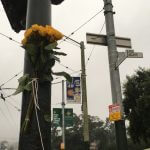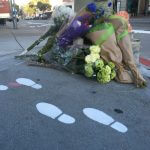What can be done right now to prevent more tragedies on our streets? Here’s what
Nine people have been hit and killed on our streets while walking and biking this so far this year. These are our neighbors, our friends, our family members. Madlen Koteva was just 14 years old when she was fatally hit in March while crossing the street with her mother and dog.
The frequency of traffic deaths this year is distressing. If things continue at this rate, San Francisco’s goal of Vision Zero will slip out of sight. This cannot happen.
Our city can and must do exponentially more to address the crisis on our streets. We all know this.
Here’s what we’re asking our city leaders to do right now – and how you can help.
GET VISION ZERO IMMEDIATELY BACK ON TRACK.
San Francisco has 130 miles of streets that are designated as “high-injury.” We call them “deadly.” Progress in fixing these streets has been both piecemeal and at a snail’s pace. We are losing precious lives in the meantime.
Every elected and agency leader must make bringing comprehensive safety improvements to high-injury streets their priority, and back this up by mandating urgency, action, and resources.
Mayor Breed has shown she’s serious about moving projects a whole lot faster and making sure they are strong. We need every Supervisor to join her in this, and prioritize pedestrian safety over everything else in their district and citywide.
Our Supervisors have the power to push SFMTA to streamline and standardize comprehensive safety improvements, and that’s what they must do. No more watered-down projects. No more drawn-out planning processes.
BRING EVERY POSSIBLE SAFETY TOOL TO INTERSECTIONS AND CROSSWALKS ON THE MOST DANGEROUS STREETS.
We must shift street safety improvements to be proactive instead of always reactive. Daylighting is a proven, cheap, and easy way to save lives. Daylighting improves visibility by moving parking back to a minimum of 10 feet from a crosswalk or intersection. It’s good for people walking and driving! We want it at every intersection on the city’s deadliest streets, known as high-injury corridors.
Supervisor Yee is introducing a resolution at the Board of Supervisors on May 7th directing the SFMTA to systematically implement an aggressive plan to bring daylighting to all intersections on the high-injury corridors. Ask your Supervisor to sign on as a co-sponsor of this resolution immediately.
We need to minimize the potential for collisions from turns altogether. This means restricting right turns on red lights at high-injury intersections to minimize the potential for collisions when a person is in the crosswalk. New York City has implemented left turn traffic calming, where rubber bumpers are strategically placed in an intersection; they slow down drivers by up to 40% and give them better visibility of the crosswalk by forcing them to make wider turns. We want both in San Francisco, and SFMTA must pilot these immediately.
BRING DOWN SPEEDS CITYWIDE.
Speed is the number one factor in severe and fatal crashes in San Francisco. A person hit by a car at 20 MPH has a 90% chance of survival; at 40 MPH they have a 15% chance of survival.
So many of our streets were designed to move vehicles fast. Multiple, wide lanes (especially one-ways like you see in Tenderloin, SOMA, and downtown) encourage faster speeds. This type of street design runs counter to safety for people walking, biking, and taking transit. But there’s a cheap and easy fix: when you add simple paint and posts to narrow lanes, traffic is significantly calmed. Let’s do this!
Let’s take a page out of the book of other Vision Zero cities, too. Residential streets in Seattle and Portland are now 20 MPH. We think 20 is plenty for San Francisco. Changing speed limits will require state legislation; we are more than ready to build a campaign and work with all city leaders to win this.
And then of course there’s speed enforcement, which is currently far from sufficient. While the SF Police Department has committed to “Focus on the Five” – to issue half of traffic citations to the five most common causes of collisions and injuries (speeding, violating pedestrian right-of-way in a crosswalk, running red lights, running stop signs, and failing to yield while turning), they aren’t yet meeting this goal. We also must get a major campaign in motion so that we can finally bring speed safety cameras to San Francisco (state legislation is also needed for this).
ADDRESS THE NUMBER OF VEHICLES ON OUR STREETS.
What we’ve described above is by no means exhaustive nor sufficient in terms of how we transform San Francisco’s streets to be truly safe for all. Traffic entering San Francisco has grown by 27 percent since 2010. There has been an explosion of Uber and Lyft vehicles, and delivery vehicles, too, for everything from Amazon to takeout.
We need to address this in big ways. That includes congestion pricing, sooner than later. Prioritizing Muni on our streets, plus making Muni service robust and reliable, is a key piece of the puzzle, too. And we need to create more car-free spaces, starting with removing private vehicles from Market Street this year.
LET’S DO THIS.
The list above is long, but we cannot be daunted by it. We cannot “chip away” when it comes to saving lives in San Francisco. Of all cities, ours could lead the way to ending severe and fatal traffic crashes.
But it will take political will to make this happen, and political will depends on people like you and me making a whole lot of noise.
So here are three things you can do right now to support safe streets.
- Call your Supervisor (look up your Supervisor). Tell them you want them to act boldly to fix our most dangerous streets, bring down speeds, and address the growing number of vehicles. Tell them why you care and that you’re counting on them.
- Send an email right now to Mayor London Breed and other elected officials via our action form asking for accountability and fast action on Vision Zero.
- Become a member of Walk San Francisco today. Ask your neighbors to join, too. The future of our streets is on the line right now. The stronger our membership, the stronger our collective voice can be. Join now.




